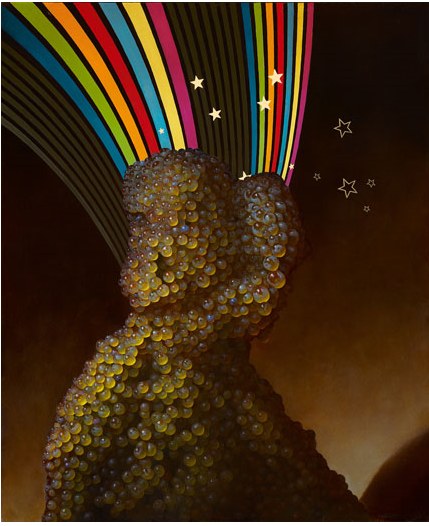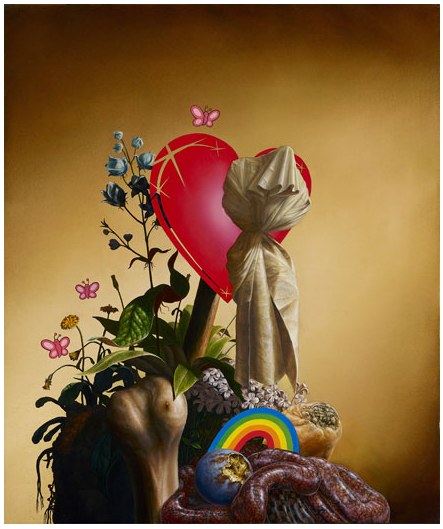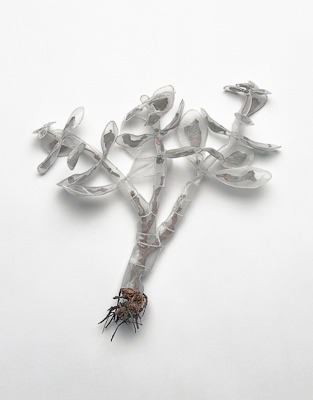No matter how wide the panorama or abstract the result, all painting is still life, a frozen arrangement of shape, color, mood and space. Ripe: Juicy Contemporary Still Life at Seattle Pacific Art Center takes a more traditional view, focusing on objects painted in cunning display, or, in the case of Linda Hutchins, sewn.
When I think of ripe and juicy, Marilyn Minter comes to mind, and John Currin. I like my ripe in the edge of rotten: leaves in the fall, not early blooms in the spring. For hard core still life, nobody beats the 17th Century Dutch, although in France Chardin achieved a mournful reply, his simplicities achieving a depth to rival Vermeer‘s. In the 20th Century, Morandi in Italy stands above everyone else. Pop art is not juicy, but Wayne Thiebaud’s cupcakes in San Francisco staked a claim to the quality and brought it home. Luscious and moist, they are nevertheless billboard-style streamlined.
Curated by Katie Kresser, Ripe comes down firmly on the side of subject matter instead of execution. Since my understanding of art reverses the two, there is much here that is not up my alley. By my lights, Natalie St. Martin is a botanical illustrator. Her fruit are ripe, but her delivery is dry. Gregory Jacobsen paints messes, yet the mess is disengaged. Steve Levin specializes in fussy excess. The gooey riot of his forms is sterilized by his delivery.
I didn’t see Zack Bent’s video, not being aware that it’s only on view 1 to 3 p.m. Don’t let the sign in the gallery give false hope. It claims a gallery attendant will be able to produce a key to trigger operation, which ain’t necessarily so.
Christian van Minnen deserves to be in an exhibit of this title, but unfortunately, he seems to be poised in the middle of a difficult transition. His strengths include a Medieval sense of form and a ghoulish intensity to his delicate paint handling. Recently, however, reactionary Pop elements have reared their ugly heads.
In Uvas, the Peter Max-like rainbow and stars shooting out of the head of the figure made of dusty, translucent grapes does it no favors.
 Ditto the Valentine heart and comic-strip butterflies in Hearthead.
Ditto the Valentine heart and comic-strip butterflies in Hearthead.
 His fabulous intestinal snake protrusion at the painting’s lower right, however, highlights what is wrong with Jacobsen’s work. Like van Minnen, Jacobsen glamourizes rot. Rot is Jacobsen’s subject, but his execution does not grip the subject. His work is a map to a place instead of place.
His fabulous intestinal snake protrusion at the painting’s lower right, however, highlights what is wrong with Jacobsen’s work. Like van Minnen, Jacobsen glamourizes rot. Rot is Jacobsen’s subject, but his execution does not grip the subject. His work is a map to a place instead of place.
Linda Hutchins‘ real jade plant sewn into a transparent organza shroud is lovely. As in the Biblical promise, that every hair is counted, every leaf is honored.
 That leaves Eric Elliott. The space in his paintings is a contagion. It sticks to leaves and cramps their
That leaves Eric Elliott. The space in his paintings is a contagion. It sticks to leaves and cramps their
blooms, which press powerfully back, holding their own. He animates
sludge, which is no small thing.
Through Dec. 3.



So good to be reading you again!
I’m trying to get my mind around your dichotomy of subject matter and execution. The examples you offer don’t clarify it for me. Marilyn Minter and Juhn Currin are so strongly figurative that their subject matter is clearest in communication– and they would seem a strange fit for a show by this title. Ripe and juicy, yes, but contemporary still life? All your other examples are subject matter based as well. Who are some that really would enrich the execution side of this concept?
I guess you can broaden the term “still life” into a general stew (which doesn’t seem especially useful), but when I hear the phrase I think “table”… a small corner of the world brought into arranged concert for study. Many times, frankly, I’m uninterested in the genre, so one of the things I enjoyed so much about this group of artists was that they interpret that slow study in a way that stirs my blood (a shame that you missed Zack’s piece, for this reason… it is a sloooooow study…). Eric Elliott’s summoning of form from middle matter and Linda Hutchins’ encasement of a withering specimen are terrific, but I also really enjoyed the way Christian Van Minnen’s earthy surfaces glinting with careful light-distinction are rudely interrupted by chintzy flat noises. It’s a conscious sabotage of his own ability to paint like an old master, and I find that fascinating. Steve Levin’s curio cabinets are made from a loose categorization that is amplified by the tidy shallow space that they occupy. I found them more personal than sterile.
My main desire for the show was a greater branching from painting.
Regina,
It’s worth a return visit with an appointment to see Zack Bent’s video installation! If that’s not possible, may I describe the work to you, and tell you why it’s the most extraordinary work I’ve seen all year?
A jar of molten lard sits on a table, cooling from liquid to solid over the course of half an hour. It’s simultaneously mundane and beautiful as it slowly changes from clear/transparent to milky/opaque. The video is projected onto a white panel that is framed and hangs on the wall, a stand-in for both a painting and a video monitor whose image quality is different from either a monitor’s transmitted light, or a projection’s typically larger size.
I could go on about more of Zack’s specific choices (lighting, color, sound …), but the bottom line is the work transcends them all. It’s drop-dead gorgeous, subtle, and smart on multiple levels. I hope you get to see it!
– Linda
p.s. I appreciate the “every hair counted” reference. Thanks!
– Linda
Oh the tyranny of quick posts. I came out like a snortin’ bull intent on a few phrases in your review. Forgive my punchy tone.
Hi Gala. If I had to apologize for every bull snort, I’d need a form letter for all the sorry. Nothing to forgive; I appreciate your vigor. Regina